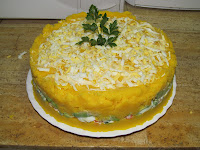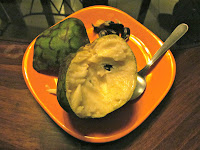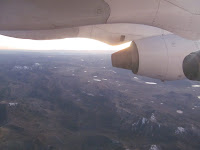Some people walk like an Egyptian. Some people curse like a sailor. Some people do everything like a Roman (when they're in Rome). And some people dance like no one is watching. But let's be serious. We know what everyone really wants to do. They want to
Peruvians love food, and they are really darn good at making it. Nothing gives you an appetite like climbing around in the Andes mountains all day... so over the years the Peruvian people have come up with some seriously yummy noms (now there's a sentence that's untranslatable to Spanish) that I was able to test during my two months there.
So, next time you're feeling hungry (and have a couple key ingredients available), just follow this step-by-step guide for a delicious Peruvian meal!*
Step 1: Pour Yourself a Drink
For the record, the legal drinking age in Peru is 18. So I was allowed to have this.
Mate de Coca - Tea made with the leaves of the coca plant, which is great for curing altitude sickness. This probably has something to do with the fact that coca leaves are the raw material of cocaine. But you have to add lots of horrible chemicals to make that... in leaf-and-hot-water form, they're perfectly safe and just taste like regular old tea.
Chicha Morada - Made from purple corn, this refreshing drink was first developed by the Incas and is still extremely common. It's sort of a cross between grape juice and iced tea.
 |
| Maíz Morada (purple corn) |
Chicha Morada - Made from purple corn, this refreshing drink was first developed by the Incas and is still extremely common. It's sort of a cross between grape juice and iced tea.
Step 2: Grab a pre-dinner snack
 |
| See the baby? |
 |
| Chapla with avocado |
 |
| Causa Limeña |
 |
| Alien Fruit |
Step 3: Take a trip to Petco
Cuy - One of Peru's most famous and popular dishes. Cuy translates to... guinea pig. Yes. I'm sorry. Guinea pig were originally domesticated thousands of years ago in Peru as food, despite their cuddliness. Guinea pig can be eaten breaded and baked, fried, or in soup. It is chewy, not particularly flavorful, and has a lot of tiny bones. Have to say, this wasn't my favorite meal.
Peruvians also eat alpaca (tastes like steak, but better), frog juice, and, in the city of Huari, they make cat stew. Really.
Step 4: In case you don't want to eat Fluffy
First of all - every single dish is served with potatoes or rice. Or potatoes AND rice. So just embrace the starch.
Lomo saltado - A stir-fry made of beef, onions, tomatoes, peppers, and spices. Served with french fries and rice.
 Ají de Gallina - A creamy, spicy chicken stew served with rice. Don't buy this (or anything, really) from a street vendor in Ayacucho, because even though it looks really good you may get sick. I tell you this from experience.
Ají de Gallina - A creamy, spicy chicken stew served with rice. Don't buy this (or anything, really) from a street vendor in Ayacucho, because even though it looks really good you may get sick. I tell you this from experience. Chicharrón and Puca Picante - Chicharrones are grilled chunks of spiced pork, sold on every street corner in towns like Huamanga. Traditionally served with puca picante, potatoes in spicy peanut sauce, and rice.
Chicharrón and Puca Picante - Chicharrones are grilled chunks of spiced pork, sold on every street corner in towns like Huamanga. Traditionally served with puca picante, potatoes in spicy peanut sauce, and rice. Ceviche - Another famous dish, which is shocking since there aren't usually potatoes or rice involved. The Peruvian equivalent of sushi, it is raw fish "cooked" in a mixture of lime juice, spices, and onions known as Leche de tigre, or "milk of the tiger".
Ceviche - Another famous dish, which is shocking since there aren't usually potatoes or rice involved. The Peruvian equivalent of sushi, it is raw fish "cooked" in a mixture of lime juice, spices, and onions known as Leche de tigre, or "milk of the tiger".Step 4: Order out
Just in case you're not full yet...
Chifa - Chinese-Peruvian fusion, mixing traditional recipes with Peruvian spices. To me, it honestly just tasted like regular Chinese food. But that is not a bad thing at all!
Step 5: Indulge your sweet tooth
 Suspiro de Limeña - Literally "Limeña (from Lima) Woman's Sigh", this is a light caramel pudding with meringue on top.
Suspiro de Limeña - Literally "Limeña (from Lima) Woman's Sigh", this is a light caramel pudding with meringue on top.Picarones - Peruvian donuts made from sweet potato flour. Deep fried and covered with cane sugar syrup, they are not very good for you. At all. But they are delicious.
 Helado de Ajonjolí - Sesame ice cream. This refreshing treat is made by traditional women in the main plaza of Ayacucho, and is pretty fun to watch.
Helado de Ajonjolí - Sesame ice cream. This refreshing treat is made by traditional women in the main plaza of Ayacucho, and is pretty fun to watch.Or you can just go to Manolo, our favorite dessert shop in Lima. You can see why it's a favorite.
¡BUEN PROVECHO!
Enjoy!
In case you'd actually like to try any of these things, here are some US restaurants that I can recommend!
Massachusetts: Machu Picchu in Somerville
They often have live music, it's a lot of fun!
Rhode Island: Los Andes in Providence
Literally the best Lomo Saltado that I've ever had, even after Peru.
Illinois: My apartment in Evanston. Let me cook for you! (I can also send you recipes for most of these dishes)
And as a bonus, dessert recepes from my wonderful baker family in Ayacucho!
https://docs.google.com/document/d/1KEwBh6psIqRySwR-7b-DkYRGdSXNx67WxTsfLNFDN0k/edit





















